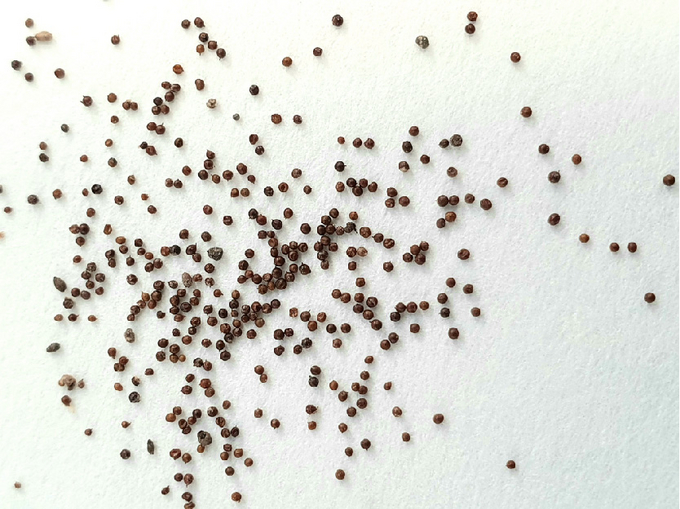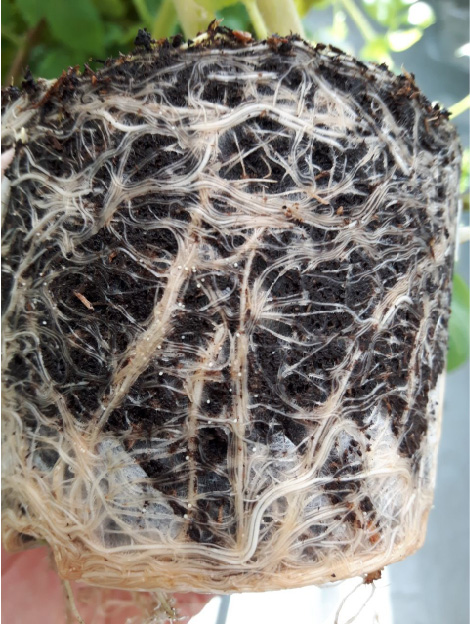Potato cyst nematodes
Globodera rostochiensis, G. pallida
Profile
Potato cyst nematodes are the most economically important animal pests of potatoes. Infestation with potato cyst nematodes results in poor growth and stunted plants. Globodera rostochiensis and Globodera pallida are listed as Union quarantine pests and are thus subject to legal regulations to prevent their introduction and spread into or within the member states of the EU.
Appearance
Potato cyst nematodes are microscopic nematodes that live in the soil and parasitize the roots. The larvae of the second larval stage are colorless and transparent and about 0.5 mm long. They possess a strong oral spine. Cysts average 0.5 to 0.8 mm in size and are round. Immature cysts are white/yellowish while mature cysts are brown in color.


Biology
Potato cyst nematodes are two species of nematodes (Nematoda) from the family Heteroderidae: yellow potato cyst nematode(Globodera rostochiensis) and white potato cyst nematode(Globodera pallida). Each species in turn produces different pathotypes or virulence groups.
The developmental cycle of potato cyst nematodes occurs through the egg stage, the worm-like larval stages (L1-L4), to the sexually mature animals in about eight weeks.
The larvae survive protected in cysts in the soil. Only when they are attracted by certain substances in the root exudates of the potato root do they leave (2nd larval stage) the cyst or hatch (from about March). Then they penetrate the root and affect root growth by their sucking activity. Through several molts, they develop into females and males through the third and fourth larval stages. The females swell into spherical structures and burst out of the root tissue with their posterior body section. The motile, worm-like males migrate out of the root and fertilize the females. The eggs produced by the females (up to 300 or more) remain inside the body, after which the female dies. The outer skin transforms into a solid brown shell (cyst) and falls off the root. These cysts survive viable in the soil for years (up to 20 years). There is one generation per year.
Damage symptoms

A first symptom of a more severe nematode infestation is poor emergence of the potatoes. Infested plants are retarded in growth, yellowing and stunting. The damage usually occurs in nests in the field or in the direction of cultivation.
In cases of minor or late infestation, above-ground symptoms are often not pronounced. About ten weeks after potatoes are laid, very small, spherical cysts on the roots may be visible to the naked eye.
Distribution
The potato cyst nematodes originated in South America and probably reached Europe with potatoes in the mid-19th century. From Europe, they spread to other areas with the seed potatoes. Today, there is a worldwide distribution, from the temperate climate zone to sea level and in the tropics in the higher regions, practically everywhere where potatoes are grown.
Propagation and transmission
Globodera rostochiensis and G. pallida are spread by passive transport. Soil from contaminated fields containing cysts or infested potatoes and soil adhering to processing equipment (e.g., on farm machinery) contribute to spread. Consideration should also be given to the transport of cysts by wind and water from unremediated areas, as well as spread by common harvesting machinery, etc.
Prevention and control
Potato cyst nematodes are difficult to control due to their resistant cysts. Remediation of infested areas is only possible in the long term. Successful sanitation requires collaborative action and measures in the affected growing areas.
Preventive measures
- Use only officially approved planting material that has been checked for freedom from infestation by nematodes in accordance with phytosanitary regulations.
- Timely detection of infestation by soil testing for potato cyst nematodes one year before planned cultivation (mandatory for seed potato cultivation).
- Farm hygiene: in case of nematode infestation on the farm, cleaning of cultivation equipment, footwear and vehicles is of great importance to prevent spreading of the cysts with soil to further areas. Waste soil from sorting should never be spread on arable land or on the manure heap (risk of nematode spread with manure spreading).
- Crop rotation: Potato cyst nematodes are typical crop rotation pests, therefore a wide crop rotation reduces the risk of infestation or the infestation density of the nematodes (e.g. potatoes at most every four years on the same area). The most effective control is consistent suspension of potato cultivation for a period of 15 - 20 years.
- Weed control: potatoes growing through the soil provide ideal propagation opportunities for potato cyst nematodes; after harvest, potatoes left lying on the ground should be removed or brought to the surface to freeze out.
- Weed control: various wild plants of the nightshade family contribute as host plants to further propagation of potato cyst nematodes.
Cultivation of nematode-resistant potato varieties
- Selective cultivation of nematode-resistant potato varieties prevents severe infestation increase and nematode density can be reduced up to 88% after one year of cultivation and up to 99% after three years of cultivation.
- Nematode-infested areas can be rehabilitated in the long term with the cultivation of nematode-resistant varieties in consumer crops.
- According to the EU Directive and the regulations of the German states, only consumption potatoes with corresponding nematode resistance may be grown on nematode-infested areas.
- The pathotype present in the field can be determined by means of a pathotype test (biotest). (Pathotypes or virulence groups: Ro1, Ro2/3, Ro4, Ro5, Pa1, Pa2/3).
- Nematode-resistant varieties can also be used preventively on nematode-free fields. Crop rotation should continue to be followed to avoid selecting resistance breakers.
Phytosanitary status
Yellow potato cyst nematode(Globodera rostochiensis) and white potato cyst nematode(Globodera pallida) are listed as Union quarantine pests and are thus subject to legal regulations to prevent their introduction and spread into or within the member states of the EU.
Last updated: 03.10.2025
automatically translated